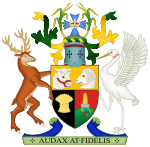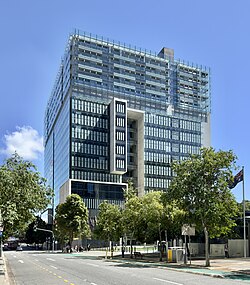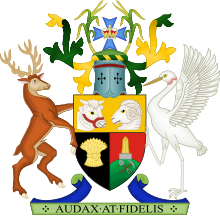Supreme Court of Queensland
| Supreme Court of Queensland | |
|---|---|
 | |
 Façade of the Queen Elizabeth II Courts of Law building in Brisbane—the main sitting location of the Court. | |
 | |
| 27°28′4″S 153°1′14″E / 27.46778°S 153.02056°E | |
| Established | 7 August 1861 |
| Jurisdiction | Queensland |
| Location | Brisbane |
| Coordinates | 27°28′4″S 153°1′14″E / 27.46778°S 153.02056°E |
| Composition method | Judges appointed by the governor on the advice of the premier (following consultation with the attorney-general and Cabinet) |
| Authorised by | Queensland Parliament via the:
|
| Appeals to | High Court of Australia |
| Appeals from | District Court of Queensland |
| Judge term length | mandatory retirement by age of 70 |
| Number of positions | 26 |
| Website | www.courts.qld.gov.au |
| Chief Justice of Queensland | |
| Currently | Helen Bowskill |
| Since | 7 September 2015 |
| President of the Court of Appeal | |
| Currently | Debra Mullins |
| Since | 3 April 2017 |
| Senior Judge Administrator, Trial Division | |
| Currently | Glenn Martin |
| Since | 24 August 2021 |
The Supreme Court of Queensland is the highest court in the Australian State of Queensland.[1] It was formerly the Brisbane Supreme Court, in the colony of Queensland.
The original jurisdiction of the Supreme Court allows its trial division to hear civil matters involving claims of more than $750,000; criminal matters involving serious offences (including murder and manslaughter); and matters arising under the Corporations Act 2001 (Cth) and cross-vesting legislation.[1] A jury decides whether the defendant is guilty or not guilty. The division also hears all civil matters involving amounts of more than $750,000. A jury may decide these disputes.
The appellate jurisdiction of the Supreme Court allows its Court of Appeal to hear cases on appeal from the District Court, the trial division of the Supreme Court, and a number of other judicial tribunals in Queensland.[1] Decisions made by the Supreme Court may be taken on appeal to the High Court of Australia in Canberra only by a grant of special leave of the High Court of Australia.
History
[edit]The Supreme Court of Queensland was founded on 7 August 1861, with the assent of the Supreme Court Constitution Amendment Act 1861 (Qld). Two subsequent pieces of legislation, including the Additional Judge Act 1862 (Qld) and the Supreme Court Act 1863 (Qld), were also necessary to establish the court's operating system.[2]
Prior to separation of Queensland from New South Wales, the former naval officer, Captain John Clements Wickham, tried minor crimes in the Moreton Bay District. More serious cases were tried at the Supreme Court of New South Wales in Sydney. Two years before separation from New South Wales, the Moreton Bay Supreme Court Act 1857 (NSW) established the jurisdiction of the Supreme Court of New South Wales in the Moreton Bay District and Samuel Milford served as Judge. Milford resigned in February 1859, and was replaced by Alfred Lutwyche.[2]

Initially, the Brisbane Supreme Court served as the Supreme Court for all of Queensland. As the colony's population grew, two other courts were constructed. The first sittings of the Northern Supreme Court were held at Bowen in 1874 and the Bowen Court House was built in 1880 in a classical revival style. The Central Supreme Court was officially opened at Rockhampton in 1896. After the opening of the Central Supreme Court at Rockhampton, the Northern Supreme Court moved from Bowen to Townsville. Justice Virgil Power, who served as the first Judge of the Central Supreme Court, was the first Queensland-born Supreme Court Judge. As the population of Queensland has grown, additional courts have been built at locations such as Bundaberg, Mackay, Cairns, Longreach, Maryborough, Roma and Townsville.[2]
Although the Brisbane Supreme Court initially served the needs of the entire colony of Queensland, it did not occupy a purpose-built building until 1879. Until then, the Brisbane Court sat at the Old Convict Barracks in Queen Street. These barracks were in disrepair and a number of improvements, including new sets of windows, had to be constructed to allow the continued sitting of the Court. Furthermore, on Sundays, the area of the barracks used by the Court was also used as a church. Although the Court's surroundings were not elaborate, Parliament did provide an annual grant towards the establishment of a Supreme Court Library from 1861 to 1879.[2]
By 1870, despite minor building modifications to the convict barracks, it had become clear that a new building was required to house the Brisbane Supreme Court. A site on George Street was selected and the prominent colonial architect, Francis Drummond Greville Stanley, submitted plans for an elaborate neoclassical building which was two storeys tall. These original plans featured stone floors and other sophisticated details. They were later modified for financial reasons and in 1875 John Petrie successfully tendered to construct the building.[2]


On 6 March 1879, the new Supreme Court opened. The entrance on the North Quay frontage had been designed as the main entrance but this was soon superseded by the George Street entrance. In 1880, iron gates were also added to the building. In 1931, the Queensland Public Works Department provided funds for the renovation of the interior of the Brisbane Supreme Court.[2]
On the night of 1 September 1968, the building that housed the Brisbane Supreme Court was damaged by arson.[3] It was subsequently demolished, and in 1976, it was replaced with a building designed by Bligh Jessup Bretnall and was opened by Queensland Governor Sir James Ramsay on 3 September 1981.[2]
In 1989, Justice Angelo Vasta was removed from the court by Queensland Governor on the request of the Parliament. This was the first time since federation that any state had used that method to remove a sitting judge from a Supreme Court.[4] Vasta was found to be not "a fit and proper person to continue in office" after giving false evidence to an investigation related to the Fitzgerald Inquiry.
In 2008, a $600 million building program began to create a new Brisbane Supreme Court and District Court building, designed by Architectus Brisbane, led by Prof John Hockings. The building is known as the Queen Elizabeth II Courts of Law and was officially opened on Friday 3 August 2012 by Queensland Governor Penelope Wensley. It incorporates a public plaza and links to the existing Brisbane Magistrates Court building.[5] The precinct occupies an entire city block between George, Roma, and Turbot streets.[2]
Composition
[edit]| Queensland Court Hierarchy |
|---|
 |
| Federal Law Courts |
| Queensland Law Courts |
|
| Tribunals |
In 1991 the Queensland Supreme Court was restructured into two divisions, the Trial Division and the Court of Appeal. The Court is headed by the Chief Justice of Queensland (currently Chief Justice Helen Bowskill) who sits in both the Trial Division and the Court of Appeal.
The Court of Appeal comprises the President (currently President Debra Mullins) and four Judges of Appeal, who sit only in the Court of Appeal. Proceedings in the Court of Appeal are usually heard by three judges. The Trial Division comprises a number of trial judges and is headed by the Senior Judge Administrator (currently Justice Ann Lyons). Proceedings in the Trial Division are heard by one trial judge. Most trial division judges also rotate through the Court of Appeal, usually for three week periods.
Appeals from:
- The Trial Division is heard by the Court of Appeal; and
- The Court of Appeal is heard by the High Court of Australia.
The Court of Appeal also hears appeals from the District Court of Queensland.
Judges of the Court as of March 2022[update] are:
| Position | Name | Date appointed | Term in office | Notes |
|---|---|---|---|---|
| Chief Justice | Helen Bowskill | 22 March 2022 | 2 years, 285 days | [6] |
| President, Court of Appeal | Debra Mullins AO | 3 April 2017 | 7 years, 273 days | [6] |
| Judge of Appeal | John K. Bond | 22 April 2021 | 3 years, 254 days | [6][7] |
| Hugh Fraser | 25 January 2008 | 16 years, 342 days | [6] | |
| Philip McMurdo | 24 November 2015 | 9 years, 38 days | [6] | |
| Philip M. Morrison | 1 August 2013 | 11 years, 153 days | [6] | |
| Debra Mullins AO | 12 December 2019 | 5 years, 20 days | [6] | |
| Senior Judge Administrator | Glenn Martin AM | 25 March 2022 | 2 years, 282 days | [6] |
| Judge | Peter Applegarth AM | 28 August 2008 | 16 years, 126 days | [6] |
| David Boddice | 2 July 2010 | 14 years, 183 days | [6] | |
| Thomas Bradley | 3 December 2018 | 6 years, 29 days | [6] | |
| Susan Brown | 16 December 2016 | 8 years, 16 days | [6] | |
| Martin Burns | 18 December 2014 | 10 years, 14 days | [6] | |
| Graeme Crow | 26 February 2018 | 6 years, 310 days | [6] | |
| Jean Dalton | 24 February 2011 | 13 years, 312 days | [6] | |
| Martin Daubney | 13 July 2007 | 17 years, 172 days | [6] | |
| James Douglas | 27 November 2003 | 21 years, 35 days | [6] | |
| Paul Freeburn | 20 May 2021 | 3 years, 226 days | [6] | |
| Peter Flanagan | 27 June 2014 | 10 years, 188 days | [6][8] | |
| James Henry | 12 September 2011 | 13 years, 111 days | [6] | |
| David Jackson | 8 October 2012 | 12 years, 85 days | [6][9] | |
| Declan Kelly | 6 September 2021 | 3 years, 117 days | [6] | |
| Duncan McMeekin | 15 October 2007 | 17 years, 78 days | [6] | |
| Kerri Mellifont | 4 November 2021 | 3 years, 89 days | [6] | |
| David North | 18 July 2011 | 13 years, 167 days | [6] | |
| Soraya Ryan | 9 March 2018 | 6 years, 298 days | [6] | |
| Frances Williams | 17 February 2020 | 4 years, 319 days | [6] |
Noted former judges
[edit]- The Honourable Paul de Jersey AC, who later became Chief Justice of Queensland and Governor of Queensland
- Catherine Holmes AC, first female Chief Justice of Queensland.
- Sir James Blair, who later became Chief Justice of Queensland, lieutenant-governor of Queensland, Knight Commander of the Order of St Michael and St George (KCMG)
- Sir Walter Campbell, who later became Governor of Queensland
- Sir James Cockle, the first Chief Justice of Queensland
- Peter Connolly
- Edward Archibald Douglas, son of Queensland Premier, John Douglas[10]
- Robert Johnstone Douglas, son of Queensland Premier, John Douglas [11]
- Sir Harry Gibbs, who later became Chief Justice of Australia
- Sir Samuel Griffith, who later became the first Chief Justice of Australia
- Alfred Lutwyche, first judge
- Thomas McCawley
- Sir Edward Williams
- Sir William Webb, later appointed to the High Court of Australia and served as President of the International Military Tribunal for the Far East
- Angelo Vasta, the first Superior Court judge removed from office through an act of Parliament
Facilities
[edit]The Supreme Court sits mainly in the Queen Elizabeth II Courts of Law in Brisbane, which also houses the District Court.[5] The court began operating out of this facility on 27 August 2012, prior to which it was located in the Law Courts Complex.[5]
The court also has judges permanently appointed to sit in Rockhampton, Townsville and Cairns, and regularly sits in other regional districts.[6]
See also
[edit]- Australian court hierarchy
- Judiciary of Australia
- List of Queensland courts and tribunals
- List of Judges of the Supreme Court of Queensland
References
[edit]Citations
[edit]- ^ a b c "Supreme Court". Department of Justice and Attorney-General (Queensland). Government of Queensland. Archived from the original on 30 June 2013. Retrieved 30 June 2013.
- ^ a b c d e f g h Robinson, Shirleene. "150 years of the Supreme Court of Queensland". Queensland State Archives. Archived from the original on 11 November 2014. Retrieved 11 November 2014.
- ^ "Labourer 'set fire to court'". The Canberra Times. 6 September 1968. p. 3. Retrieved 11 November 2014 – via National Library of Australia.
- ^ Campbell, Enid; Lee, H. P.; Campbell, Enid Mona (2013). The Australian Judiciary. Cambridge University Press. pp. 120–121. ISBN 978-0521769167. Archived from the original on 7 March 2016. Retrieved 15 October 2015.
- ^ a b c "New Brisbane Supreme and District Court". Department of Justice and Attorney General (Queensland). Government of Queensland. Archived from the original on 21 August 2013. Retrieved 15 July 2013.
- ^ a b c d e f g h i j k l m n o p q r s t u v w x y z aa ab "Judges". Supreme Court (Qld). Retrieved 28 September 2018.
- ^ "Judicial Profiles: The Honourable Justice John K Bond". Supreme Court Library Queensland. Archived from the original on 23 June 2016. Retrieved 19 September 2016.
- ^ "Judicial Profiles: The Honourable Justice Peter Flanagan". Supreme Court Library Queensland. Archived from the original on 26 February 2017. Retrieved 19 September 2016.
- ^ "Judicial Profile: The Honourable Justice David J Jackson". Supreme Court Library Queensland. Archived from the original on 22 April 2016. Retrieved 19 September 2016.
- ^ McPherson, B. H. Douglas, Edward Archibald (1877–1947). Canberra: National Centre of Biography, Australian National University. Archived from the original on 29 December 2014.
- ^ McPherson, B. H. Douglas, Robert Johnstone (1883–1972). Canberra: National Centre of Biography, Australian National University. Archived from the original on 5 March 2016.
Sources
[edit]- "Judges of the Supreme Court contacts". Queensland Courts. Archived from the original on 15 August 2016. Retrieved 28 May 2006.
- Turner, Clive 2004, Australian Commercial Law, 25th edn, Lawbook Co., Sydney.
Attribution
[edit] This Wikipedia article incorporates text from "150 years of the Supreme Court of Queensland" by Dr. Shirleene Robinson published by the State of Queensland under CC-BY 3.0 AU licence (accessed on 11 November 2014, archived on 11 November 2014).
This Wikipedia article incorporates text from "150 years of the Supreme Court of Queensland" by Dr. Shirleene Robinson published by the State of Queensland under CC-BY 3.0 AU licence (accessed on 11 November 2014, archived on 11 November 2014).
